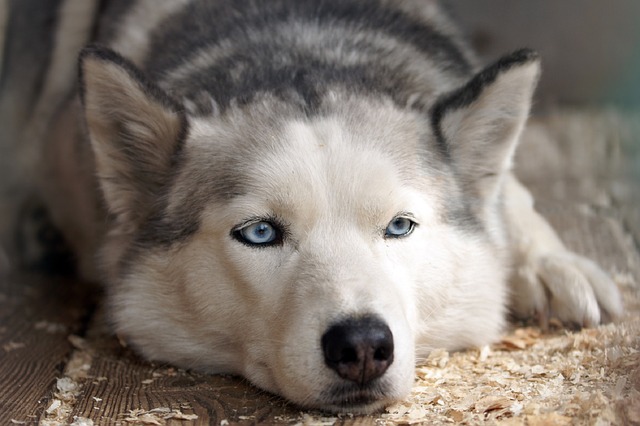
Does your dog seem to be itching more than usual lately? Maybe he has irritated areas on his skin or bald patches.
Unfortunately, skin issues are one of the top reasons for vet visits, and there are more than 160 skin problems that can plague dogs, so getting a proper diagnosis and treatment for your poor pup can be difficult. Some skin problems are more common than others, though; here are 10 common skin issues that can plague dogs.

#1 – Allergies
Allergies are a very common problem that can affect a dog’s skin. Allergies are broken down into 3 categories:
-Environmental (Atopy): Just like humans, dogs can be allergic to a wide variety of pollens and other environmental factors. These triggers may be inhaled or absorbed directly through the skin. Identifying the allergen can be a difficult task, and then allergy shots or other medication may be required to control your dog’s symptoms.
-Fleas: Any flea bites can cause itching, but some dogs are hypersensitive to flea bites, where even one nibble can cause the dog to scratch and chew themselves endlessly. Eliminating fleas from your dog and home can be challenging, but once he is free from fleas, his itching should stop.
-Food: After many decades of being fed commercial foods, some dogs are developing hypersensitivity to some ingredients, even common proteins such as beef or chicken. The only way to diagnose a food allergy is through a food elimination diet. Once the offending ingredient has been identified, supplying food without that ingredient should improve your dog’s health and happiness.

#2 – Hot spots
Hot spots, officially called acute moist dermatitis, appear as red, swollen areas of the skin that may feel hot when you touch them. They may surface anywhere but are frequently found on the chest, hips, or head, and can be caused by anything from allergies to insect bites, infections to excessive licking.
Hot spots warrant a vet visit to determine how best to treat them. It’s one thing to clear up the initial problem, but they may come back if the underlying issue that caused the hot spots in the first place is not addressed.
#3 – Lick granulomas
A lick granuloma is an irritated patch of skin caused by excessive licking – usually on the front legs – that can remove hair and affect every single layer of skin. It’s usually accompanied by bacterial or yeast infections. According to PetMD:
“The skin is so deeply affected that even down to the base layer of the skin there can be found under the microscope little pockets of bacteria, broken hair follicles, plugged and scarred oil glands and dilated and inflamed capillaries. And if these skin lesions are removed surgically, the dog simply licks at the sutures or incision line after the surgery heals, thus creating a brand new granuloma right where the original one was!”
VCA Hospitals adds:
“Also known as acral lick dermatitis, this problem begins as an area of hair loss and reddened skin most commonly on the top of the wrist or carpal joint on the front legs. It often looks like a ‘hot spot.’ These differ from ‘hot spots‘ in that they persist despite treatment. They are often associated with chronic, persistent licking, especially when the pet is alone or when the family is sleeping.”
Treating lick granulomas can be very difficult and often relies heavily on discovering what caused the dog to lick the area so much in the first place, such as an allergy or an injury.

#4 – Mange
There are two common causes of mange, sarcoptic mange and demodectic mange. Both are caused by mites, a tiny external parasite that may cause infections when they reproduce on your dog’s skin and fur.
Sarcoptic mange is also referred to as “canine scabies” and is easily spread from dog to dog. The mites can also be transferred to people, although they don’t usually survive. Affected dogs scratch endlessly, causing bald patches, inflammation, sores, and scabs. It typically starts on the face, ear, and legs, but may spread over the entire body.
Demodectic mange is not generally contagious. Even though the mites can be transferred between dogs, dogs typically carry a mite population that doesn’t cause skin irritation. Similar to sarcoptic mange, demodectic mange can cause bald spots, scabs, and sores.
If your dog appears to have mange, he should be taken to the vet to determine how best to treat it. Possible treatments may include medications, medicated shampoos, or dips. Since mange is caused by a parasite, an affected dog’s bedding, blankets, and collar should be replaced to help avoid a recurrence.

#5 – Recurring bacterial dermatitis
According to PetMD:
“Of the curable skin disorders, the most commonly seen is reoccurring bacterial dermatitis where the dog displays circular patches [of] alopecia (hair loss), scales and crusts, and tiny inflamed eruptions that evolve into additional crusty patches.
At every dermatology seminar we are reminded that most chronic bacterial dermatitis cases need to have cultures and antibiotic sensitivity tests run. And then, the appropriate antibiotic must be used for 8 to 12 weeks and sometimes much longer.
Healthy dogs seldom develop bacterial dermatitis, therefore underlying predisposing factors should be considered.”
This is one example of why skin problems can be so frustrating to treat.

#6 – Malassezia (yeast) infections
Yeast infections are a common type of skin infection, and often develop around the ears and paws. Symptoms include the dog pawing at their ears or chewing on their feet. The skin is also often irritated or discolored and may be greasy and smelly.
Cocker Spaniels and Westies are especially prone to yeast infections. Treatment may include medicated shampoo, ointment, or oral medication.
#7 – Ringworm
Ringworm is actually a fungus and not a worm, although it does cause circular patches of bald, scaly, inflamed patches of skin. Ringworm can be passed between dogs in close quarters and seems to be more common in puppies. Treatment may include medicated shampoos, ointments, or dips and possibly oral medication.
#8 – Cushing’s disease
Cushing’s disease is not a skin problem in and of itself – it’s actually a problem with the adrenal glands producing too much cortisol that causes many skin problems as symptoms of the disease. Cushing’s disease has no cure, but there are many treatments that can improve your dog’s quality of life and skin problems.

#9 – Hypothyroidism
According to Pet Coach:
“Hypothyroidism is the condition that occurs when not enough thyroid hormones are produced. Hypothyroidism causes a wide variety of symptoms, but is often suspected in dogs that have trouble with weight gain or obesity and suffer from hair loss and skin problems. Hypothyroidism is easy to diagnose with a blood test that checks the level of various thyroid hormones including T4. Most hypothyroid dogs respond readily to treatment with synthetic thyroid medication such as Soloxine. Many dogs suffer from a low thyroid hormone level for years without treatment. If your dog has chronic recurrent skin problems, or unexplained weight gain, she may be suffering from hypothyroidism.”

#10 – Dry skin
Dogs can suffer from dry skin just the same as humans. According to ASPCA Pet Insurance:
“Dry skin is another one of the most common skin problems in dogs. You can see if your dog has dry skin by parting the fur and checking for scaly or flaky skin. You may also notice redness and inflammation from scratching.
Dry skin can have a number of causes including:
Environment – Dry skin may be more prevalent in areas with low humidity. It can also be more of a problem in the wintertime when heaters are running and drying out the air.
Allergies – Allergic reactions to shampoos, fragrances, smoke or other allergens can also cause dry skin in dogs.
Dehydration – If your dog isn’t getting enough water during the day, his or her skin may start to show the effects. Make sure your dog always has clean water at hand and be sure to bring plenty of fresh water along when you go on long walks or hikes.
Dietary Issues – While too much fat in a dog’s diet can cause health problems, a lack of healthy oils can result in dry skin. Some commercial dog foods process out the healthy oils that can help promote healthy skin and fur. Be sure to look at ingredient lists and talk to your veterinarian about recommended dog food options.”

PetMD adds that supplementation with omega-3 and omega-6 fatty acids may help.
“Dogs with dry skin or a dull coat, for example, often improve with diets or supplements containing optimized levels of omega-3 and omega-6 fatty acids. Omega-3 fatty acids, often sourced from fish oil, play an important role in reducing inflammation.
Omega-6 fatty acids play a key role in maintaining the integrity of your dog’s skin as a barrier, reducing water loss and bolstering the strength of the skin cells. Linoleic is an essential omega-6 fatty acid, meaning the dog must obtain this from food sources as they cannot synthesize it on their own.”
(H/T: PetMD, PetMD, ASPCA Pet Insurance, PetFinder)
via Whisker Therapy